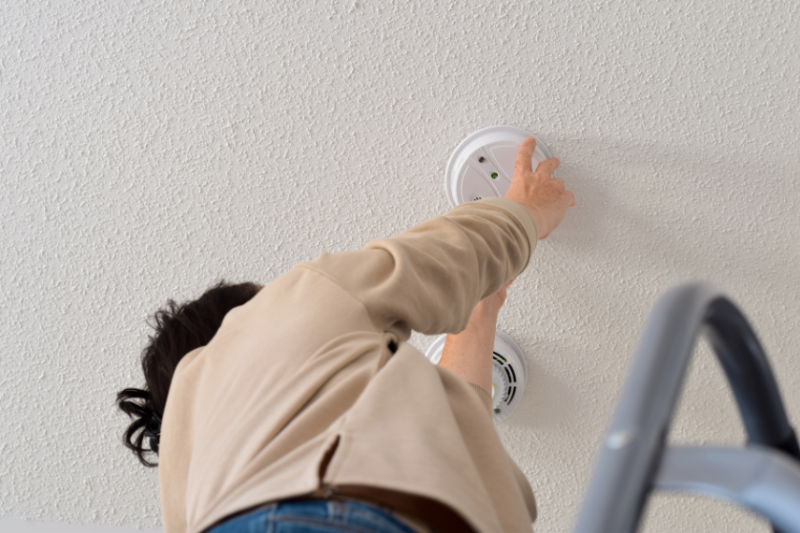
As a landlord, you’re legally required to take certain fire safety precautions to protect your tenants and property.
Here are your key responsibilities as a landlord, along with tips to help you carry out a fire risk assessment.
Landlord fire safety responsibilities
All residential landlords in the UK, regardless of the type of property, must make sure that:
- every floor of the property has a smoke alarm that’s been tested
- any room that has an appliance which burns fuel (like a wood burner) has a carbon monoxide alarm
- any furniture and furnishings you provide in the property meet fire safety standards and are appropriately labelled
- your tenants always have access to safe and reliable escape routes
- electrical wiring, sockets and fuse boxes are safe throughout the tenancy
- any gas equipment they supply is safely installed and maintained by a Gas Safe registered engineer
If the property is a house in multiple occupation (HMO), you need to provide fire alarms and extinguishers too.
An HMO is a property that’s rented by three or more people who aren’t part of the same family.
Landlord fire risk assessments
The point of fire risk assessments is to identify hazards so you can remove or reduce them.
While there’s not an official fire safety certificate, landlords should carry out regular risk assessments. They’re a legal requirement if you’re a landlord of an HMO.
The National Residential Landlord Association recommends reviewing your fire risk assessment every two years and updating it every four years.
You can assess your rental property yourself or use a reputable third-party safety inspector. Most fire and rescue services also offer free home visits to identify potential hazards.
Key things to consider for a landlord fire risk assessment
You should look for potential hazards like:
- areas of the home that need reliable smoke and carbon monoxide alarms – at least one smoke alarm per floor is a UK-wide requirement
- escape routes that aren’t clear or easy to use - make sure your tenants understand their responsibility to keep the exits clear too
- electrical appliances that don’t have the right European or British safety labels - these include the CE mark for European products and the kitemark for British products (if they don’t have this label, they need to be replaced)
- appliances that haven’t been PAT (Portable Appliance Test) tested each year – this includes white goods as well as appliances like kettles and toasters, if you’re providing them
- old or faulty gas cookers which are lit using matches rather than a spark device - this should be fixed or upgraded
Fire safety regulations for rental properties
The fire regulations for rental properties are outlined in different laws.
If you don’t comply with them, you could be fined or even get prison time. We’ve outlined some of the most important ones below.
Furniture and Furnishings (Fire Safety) Regulations 1988/1989, 1993, and 2010
These regulations state you must label all your furnishings to show they meet the specified ignition resistance levels.
Most modern items will already be labelled, so it’s particularly worth checking if you’re buying secondhand.
Alternatively, you could rent your property unfurnished – as you’re not responsible for making sure the furniture your tenants own is compliant.
The Housing Act 2004
This includes the Housing Health and Safety Rating System (HHSRS) and describes many of the fire safety responsibilities that apply to landlords in the UK.
It says there must be an easy escape route for tenants, and fire-resistant materials should be used in the design of the building.
The Regulatory Reform (Fire Safety) Order 2005
This order says the person responsible for multi-occupied residential buildings must carry out a fire assessment in communal areas.
It only applies to shared communal areas, like shared kitchens or hallways in a block of flats.
The Smoke and Carbon Monoxide Alarm (England) Regulations 2015
This requires you to install a smoke alarm on every floor and a carbon monoxide alarm in any room with a fuel-burning appliance.
As the landlord, you’re responsible for repairing and replacing faulty alarms.
The tenant must report it to you and once the report is made, you have a legal obligation to investigate and repair or replace it.
Fire safety for HMOs
If you’re a landlord of a property that is shared by three or more tenants who aren’t family members, you’re a landlord of a house of multiple occupation (HMO).
Landlord fire safety regulations are stricter for HMOs than for single properties.
This is because fire risks are higher in these properties as they’re typically large, harder to get out of, and have more people living there.
Some HMO requirements include installing fire alarms and extinguishers on every floor, providing one fire blanket for each kitchen, and fitting fire doors.
Different rules may apply to larger HMO properties. All HMO landlords need a license from the local council, and you need to liaise with them to understand your specific responsibilities.
Landlord insurance
Taking out landlord insurance isn’t compulsory, but it does provide cover against unpredictable events such as fire.
Find out more about our landlord insurance and how it can protect you and your rental property.



